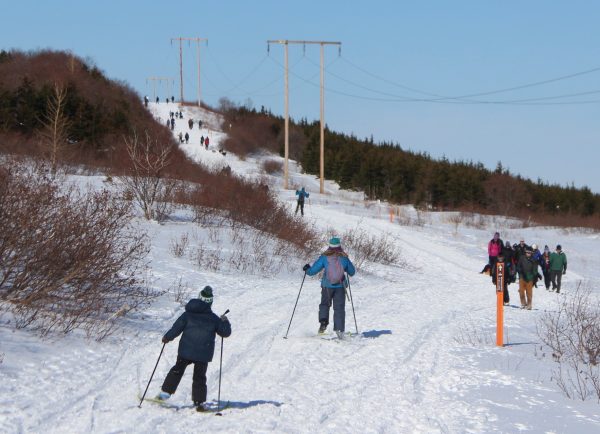
One of the biggest casualties of the coronavirus pandemic is fun — there are no sports, no going out to bars or movies.
But Alaska is one of the world’s premiere places for outdoor recreation, and public health officials here say that residents don’t have to stop going outside, as long as they’re careful.
“I don’t think there should be any risk, as long as people are adhering to the social distancing,” said Dr. Joe McLaughlin, the state epidemiologist. “It’s really important that people stay healthy and stay fit.”
Even McLaughlin, who’s at the forefront of the state’s response to the pandemic, is still carving out time for recreation — including a bike ride Thursday night.
“That was so, so helpful for me to just maintain my inner equilibrium,” he said. “But it’s been a little bit more difficult, recently.”
Read more of Alaska Public Media’s coronavirus coverage
McLaughlin isn’t the only Alaskan turning to the outdoors amid the pandemic. Officials in Anchorage and other cities and towns have ordered residents to “hunker down” in their homes, but those measures still allow people to blow off steam on trails and in other public spaces. Even Gov. Mike Dunleavy’s shelter-in-place order announced Friday includes a carveout for exercise, as long as people stay six feet away from each other.
Related: ‘We crossed a line today’: Dunleavy orders statewide shelter in place, limits travel
Officials said they’ve seen droves of people turning out to state parks in the past week, with the most pressure on popular trailheads in the Anchorage area like at Glen Alps, Prospect Heights and Hatcher Pass.
“I have never, ever seen it so busy, where you couldn’t find a parking spot. It was insane traffic, where people were just waiting outside to see if they could get a parking spot,” said Wendy Sailors, a state parks spokeswoman, who drove to the Prospect Heights trailhead Sunday. “There were bikes, there were skiers, there were families with kids, there were walkers, there were dogs.”
The state parks division issued a press release Friday saying that workers are doing the best they can to keep up with demand. “But they need help from the public,” it said.
Instead of picking one of the Anchorage area’s busier trailheads, Sailors suggested residents take a slightly longer drive to a place like Eklutna Lake, or to one of the many trails on the Turnagain Arm. She also said the parks are quieter early in the morning.
Meanwhile, in interviews, public health officials outlined a number of best practices and precautions that people should follow when going outside.
First, as much as it might be frustrating, they said they don’t want kids using playgrounds during the pandemic. One of the two likely ways the coronavirus spreads is on contaminated surfaces, and that’s a particular concern for children, who can be infected without showing symptoms.
“Kids have trouble social distancing — the little ones, they want to play, they don’t understand what’s going on,” said Darcy Harris, who manages the environmental health section of Anchorage’s health department. “Sharing playground equipment right now is probably not the best choice.”
It’s also not a good time to carpool to a trailhead, at least with people outside your family, given the guidelines for at least six feet of social distancing.
And McLaughlin said people should be very careful about using public bathrooms at trailheads, like Glen Alps. Those bathrooms have what epidemiologists call “high-touch surfaces” — their term for spots that lots of people can touch and potentially spread germs. And the coronavirus has also been found in poop.
After using a public bathroom, people should wash their hands; if that’s not possible, use sanitizer with at least 60% alcohol, McLaughlin said.
People should also be aware of wiping their noses with their mittens or hands while they’re outside, and try to take off their gloves before opening the door to their houses. And people should avoid spitting, or anything else that involves depositing bodily fluids directly into the environment.
“Please do not do the snot rockets and blow your nose when other people are around,” McLaughlin said. “We want people to be really mindful of how this virus transmits — and just be conscious of the ways you can prevent exposing yourself, and ways you can prevent exposing others.”
One piece of good news? Health officials don’t see pets as a source of infection. But they note that they can still carry germs, so be careful about touching your face if you’re going to play with somebody else’s dog or cat.
Read the latest coverage of the coronavirus in Alaska
Other than from surfaces, the main risk of getting COVID-19 comes from “close contact” with infected people — generally defined as spending five or 10 minutes within six feet. So just remember to keep your distance when you’re outside, officials said, particularly if you see someone coughing or sneezing.
And if you have to pass someone on a narrow trail?
“If you can’t get six feet away, just sort of turn away and pass quickly,” McLaughlin said. “Whatever you can do to minimize the risk of transmission of the virus through those respiratory droplets.”
Nathaniel Herz is an Anchorage-based journalist. He's been a reporter in Alaska for a decade, and is currently reporting for Alaska Public Media. Find more of his work by subscribing to his newsletter, Northern Journal, at natherz.substack.com. Reach him at natherz@gmail.com.




